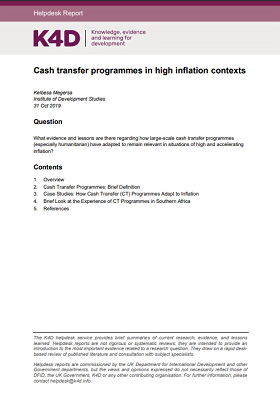Cash Transfer Programmes in High Inflation Contexts
The use of Cash Transfers (CTs) in developing regions arose as the understanding grew that some other types of aid programmes were not effectively attaining their goals. For instance, emergency food aid was responding to famines, but it was unable to add to food stability. Over time, the persistently poor became ever more reliant on food aid. Some Sub-Saharan African countries with early experiences with cash transfers, such as Malawi, had also confronted this problem and turned to cash transfers. However, the value of cash transfers can also wear down significantly in a high inflation environment. Unless the cash transfers are indexed to food prices, food transfers may be more suitable. Thus, cash transfers are not a universal solution, and local factors limiting their effectiveness need to be carefully considered (Garcia and Moore, 2012). As a result, countries such as Ethiopia currently use a combination of cash and food transfers (Sabates-Wheeler and Devereux, 2010). This report mainly relies on grey literature and various reports issued by development agencies that implement Cash Transfer programmes – due to the nature of the query and the lack of academic literature particularly on how cash transfer programmes adapt to inflation contexts.



